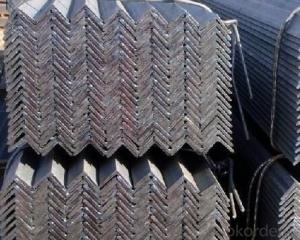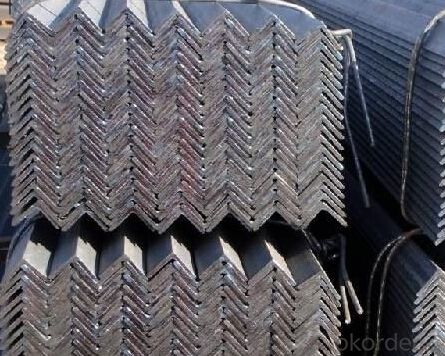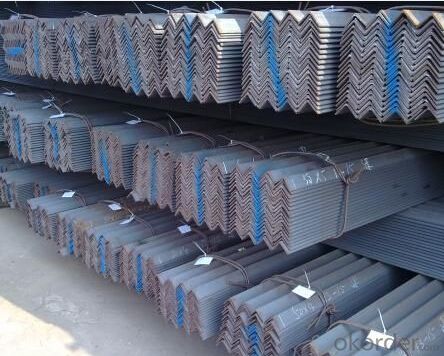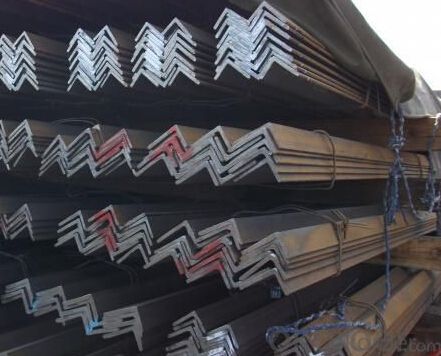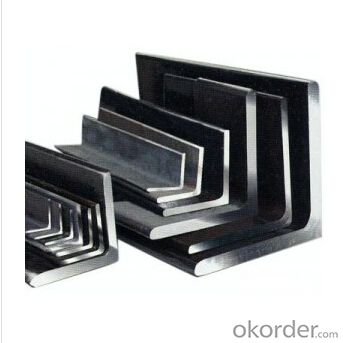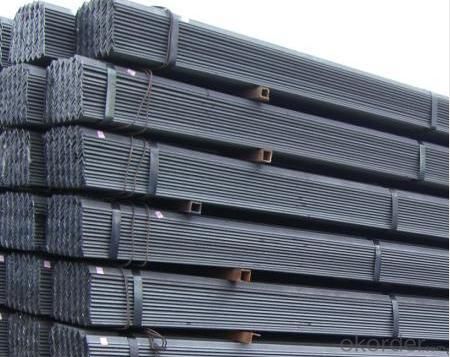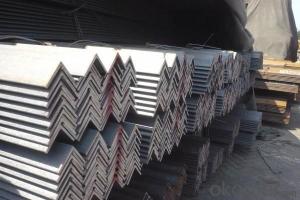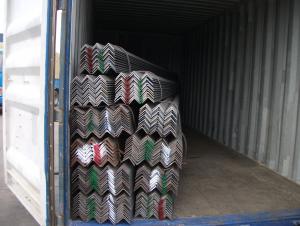Specifications of JIS G3192,SS400;SS540 Angle Steel
- Loading Port:
- Tianjin
- Payment Terms:
- TT OR LC
- Min Order Qty:
- 50 m.t.
- Supply Capability:
- 5000 m.t./month
OKorder Service Pledge
OKorder Financial Service
You Might Also Like
1. Structure of Angle Steel Description
Angle steel has equal angle, unequal angle. Standards: GB,ASTM,BS,AISI,DIN,JIS Material:Material: GB Q235B, Q345B or Equivalent; ASTM A36; EN 10025, S235JR, S355JR; JIS G3192, SS400; SS540.
Sizes:
Sizes: 25mm-250mm | ||
a*t | ||
25*2.5-4.0 | 70*6.0-9.0 | 130*9.0-15 |
30*2.5-6.6 | 75*6.0-9.0 | 140*10-14 |
36*3.0-5.0 | 80*5.0-10 | 150*10-20 |
38*2.3-6.0 | 90*7.0-10 | 160*10-16 |
40*3.0-5.0 | 100*6.0-12 | 175*12-15 |
45*4.0-6.0 | 110*8.0-10 | 180*12-18 |
50*4.0-6.0 | 120*6.0-15 | 200*14-25 |
60*4.0-8.0 | 125*8.0-14 | 250*25 |
Material details:
Alloy No | Grade | Element (%) | |||||
C | Mn | S | P | Si | |||
|
|
|
|
|
|
| |
Q235 | B | 0.12—0.20 | 0.3—0.7 | ≤0.045 | ≤0.045 | ≤0.3 | |
|
|
|
|
|
|
| |
Alloy No | Grade | Yielding strength point( Mpa) | |||||
Thickness (mm) | |||||||
≤16 | >16--40 | >40--60 | >60--100 | ||||
≥ | |||||||
|
|
|
|
|
| ||
Q235 | B | 235 | 225 | 215 | 205 | ||
Alloy No | Grade | Tensile strength (Mpa) | Elongation after fracture (%) | ||||
Thickness (mm) | |||||||
| ≤16 | >16--40 | >40--60 | >60--100 | |||
≥ | |||||||
|
|
|
|
|
|
| |
Q235 | B | 375--500 | 26 | 25 | 24 | 23 | |
2. Main Features of angle steel
Broad-spectrum
High quantity
High strength
3.Usage & Applications of GB Q235 Angle Steel
Trusses
Transmission towers;
Telecommunication towers;
Bracing for general structures;
Stiffeners in structural use.
4.Packaging & Delivery of GB Q235 Angle Steel
1. Transportation: the goods are delivered by truck from mill to loading port, the maximum quantity can be loaded is around 40MTs by each truck. If the order quantity cannot reach the full truck loaded, the transportation cost per ton will be little higher than full load.
2. With bundles and load in 20 feet/40 feet container, or by bulk cargo, also we could do as customer's request.
3. Marks:
Color mark: There will be color marking on both end of the bundle for the cargo delivered by bulk vessel. That makes it easily to distinguish at the destination port.
Tag mark: There will be tag mark tied up on the bundles. The information usually including supplier logo and name, product name, made in China, shipping marks and other information request by the customer.
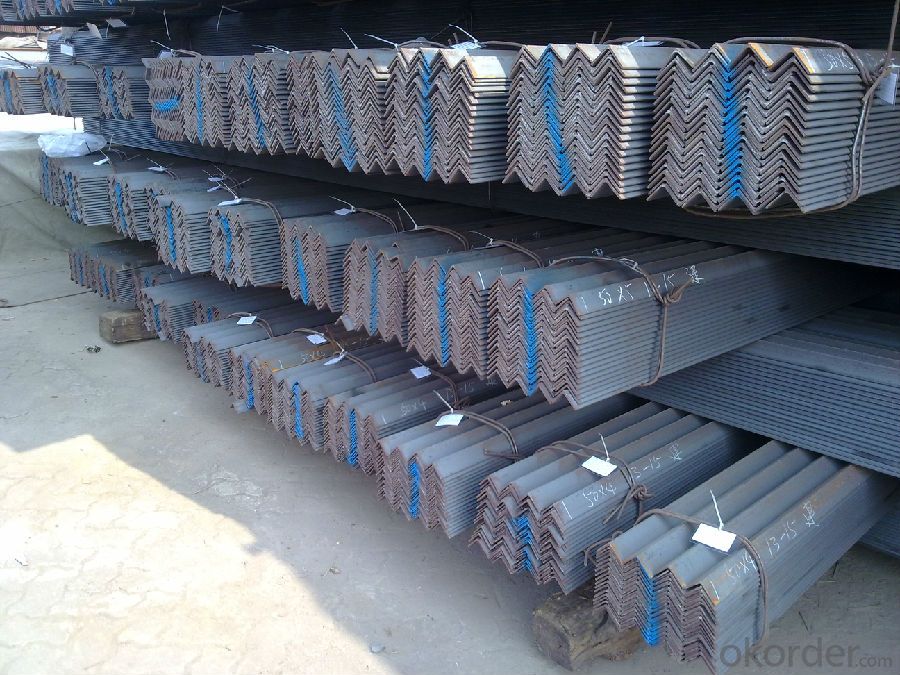
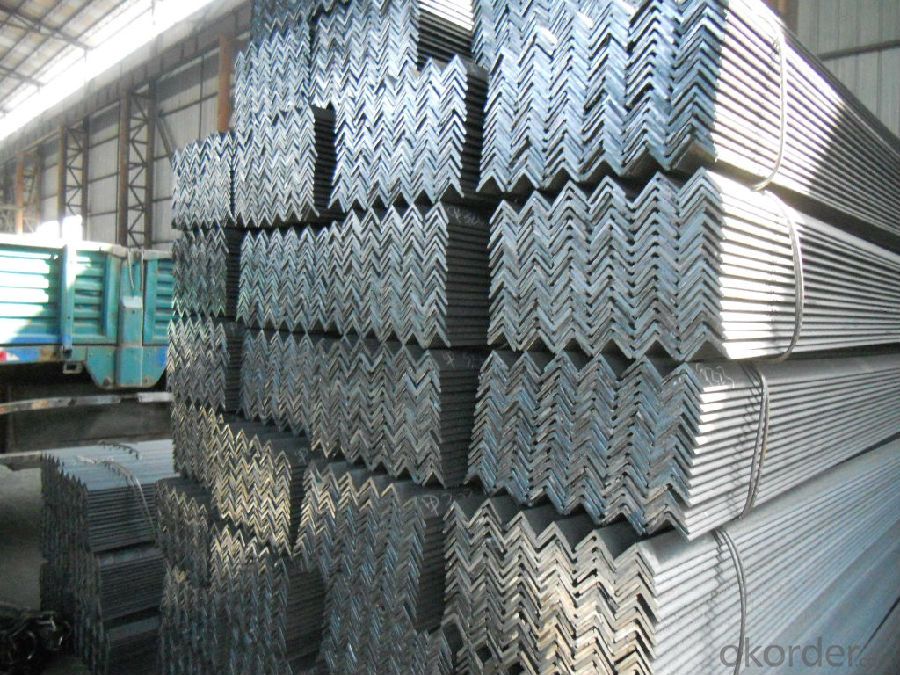
5.FAQ
We have organized several common questions for our clients,may help you sincerely:
①How about your company?
A world class manufacturer & supplier of castings forging in carbon steel and alloy steel,is one of the large-scale professional investment casting production bases in China,consisting of both casting foundry forging and machining factory. Annually more than 8000 tons Precision casting and forging parts are exported to markets in Europe,America and Japan. OEM casting and forging service available according to customer’s requirements.
②How to guarantee the quality of the products?
We have established the international advanced quality management system,every link from raw material to final product we have strict quality test;We resolutely put an end to unqualified products flowing into the market. At the same time, we will provide necessary follow-up service assurance.
③How long can we receive the product after purchase?
In the purchase of product within three working days, We will arrange the factory delivery as soon as possible. The pecific time of receiving is related to the state and position of customers.Commonly 7 to 10 working days can be served.
- Q: What are the different methods of surface painting for steel angles?
- There are several different methods of surface painting for steel angles, including brush painting, spray painting, and powder coating. Brush painting involves applying paint directly onto the surface using a brush or roller. Spray painting uses a paint gun to evenly distribute paint onto the surface. Powder coating involves applying a dry powder to the steel angle and then curing it in a high-temperature oven, resulting in a durable and long-lasting finish.
- Q: How do you bend steel angles?
- To bend steel angles, you will need to follow a few steps. Firstly, make sure you have the right tools and equipment, such as a bending machine or a bending brake. These tools are specifically designed to bend metal angles accurately and efficiently. Next, measure and mark the desired bending point on the steel angle. Use a ruler or a measuring tape to ensure accurate measurements. It is essential to have precise markings to achieve the desired angle. After marking the bending point, secure the steel angle tightly in the bending machine or brake. This will prevent any movement or slippage during the bending process. Now, carefully position the bending machine or brake to align with the marked bending point. Adjust the bending angle according to your requirements. This can usually be done by adjusting the clamps or handles on the machine. Once everything is properly aligned, apply gradual pressure to the bending machine or brake. Start with a low pressure and gradually increase it until the steel angle starts bending. Be patient and avoid applying excessive force, as this can cause the angle to deform or break. Continue applying pressure until the desired angle is achieved. Use a protractor or angle measuring tool to ensure accuracy. If necessary, make any minor adjustments to the angle by repositioning the steel angle in the bending machine or brake. Once the bending process is complete, carefully remove the steel angle from the bending machine or brake. Inspect the angle for any imperfections or deformities. If there are any issues, you may need to repeat the bending process or make adjustments to your technique. It is important to note that bending steel angles can be challenging, especially if you are not experienced or do not have the right tools. If you are unsure about the process, it is recommended to seek professional assistance or consult with a metal fabrication expert who can guide you through the bending process safely and accurately.
- Q: What are the advantages of using steel angles in manufacturing?
- Using steel angles in manufacturing offers several advantages. Firstly, steel angles possess immense strength and durability, making them suitable for a wide array of applications. They are capable of withstanding heavy loads and providing structural stability, making them an ideal choice for the construction of buildings, bridges, and other infrastructure projects. Secondly, steel angles provide versatility in terms of design. They can be easily customized and fabricated into different shapes and sizes, allowing manufacturers to create products that meet specific requirements. Whether it be a simple bracket or a complex framework, steel angles can be adapted to fit any desired design. Furthermore, steel angles exhibit excellent resistance to corrosion. They can endure exposure to moisture, chemicals, and other environmental factors, making them suitable for outdoor applications and industries where corrosion poses a concern. Another advantage of utilizing steel angles is their cost-effectiveness. Steel is a relatively inexpensive material compared to alternatives such as aluminum or stainless steel. Moreover, steel angles have a long lifespan, requiring minimal maintenance and replacement, thus reducing overall costs in the long term. Lastly, steel angles are readily available in the market. They can be easily obtained from steel suppliers, ensuring accessibility for manufacturers worldwide. In conclusion, the utilization of steel angles in manufacturing grants advantages in terms of strength, versatility, corrosion resistance, cost-effectiveness, and availability. These factors make steel angles the preferred choice for various industries, enabling them to produce high-quality, durable, and cost-efficient products.
- Q: How do steel angles contribute to the resiliency of a structure?
- Steel angles contribute to a structure's resiliency in multiple ways. Firstly, they distribute the load across different members, providing added structural support and stability. In construction projects, steel angles are often used as reinforcements or braces, enabling the transmission of forces and preventing excessive deflection or deformation. This helps the structure resist external forces like wind, earthquakes, or heavy loads, ultimately enhancing its overall resilience. Furthermore, steel angles possess high durability and corrosion resistance, further bolstering a structure's resiliency. Steel, as a material, boasts exceptional strength and longevity, making it particularly well-suited for enduring harsh environmental conditions and potential structural failures. This durability ensures the structure can withstand the test of time, reducing the need for frequent repairs or replacements and ultimately improving its overall resilience. Additionally, steel angles offer flexibility in design and construction, facilitating efficient load transfer and optimized structural configurations. They can be easily customized and fabricated to meet specific project requirements, guaranteeing the structure can be tailored to withstand various dynamic and static loads. This adaptability enhances the structure's resiliency by enabling it to adapt to changing conditions or future modifications. In summary, steel angles play a vital role in enhancing a structure's resiliency by providing additional support, durability, and flexibility. Their ability to distribute loads, resist external forces, and withstand harsh conditions ensures the structure can withstand unexpected events and maintain its integrity. As such, steel angles are an indispensable component of resilient construction practices.
- Q: How do steel angles perform under dynamic loads?
- Steel angles generally perform well under dynamic loads due to their inherent strength and durability. The structural shape of steel angles, characterized by their L-shaped cross-section, provides excellent resistance to bending and torsional forces. This design allows them to efficiently distribute dynamic loads and resist deformation, making them suitable for various applications in construction, engineering, and manufacturing industries. However, the specific performance of steel angles under dynamic loads can vary depending on factors such as the grade and quality of the steel, the magnitude and frequency of the dynamic load, and the overall design and reinforcement of the structure.
- Q: How do you specify steel angles in drawings?
- In order to specify steel angles in drawings, several key parameters need to be specified. Firstly, the angle size needs to be clearly indicated, usually by providing the leg lengths or the dimensions of the equal sides. For example, a 3" x 3" x 1/4" angle would have legs measuring 3 inches each and a thickness of 1/4 inch. Next, the type of angle needs to be indicated, such as L-shaped or unequal angles. This information is important as it helps determine the appropriate steel angle to be used for a specific application. Additionally, the material grade of the steel angle should be specified. Steel angles are available in various grades, which determine the strength and durability of the angle. Common grades include A36, A572, and A588, among others. The grade is typically specified to ensure the angle meets the required structural or mechanical properties. The length of the steel angle is another important parameter that needs to be stated in the drawing. Whether it is a fixed length or a specific range, this information enables accurate fabrication and installation. Finally, any additional requirements or specifications, such as surface finish, tolerance, or any specific treatments or coatings, should also be clearly indicated in the drawing to ensure the steel angle is manufactured and installed according to the desired specifications. By providing these parameters in the drawings, engineers, fabricators, and contractors can easily identify and accurately procure the required steel angles for construction or manufacturing purposes.
- Q: Can steel angles be used in agricultural or farming structures?
- Yes, steel angles can be used in agricultural or farming structures. They provide structural support and can be used for framing, bracing, and reinforcing various components such as barns, sheds, and livestock enclosures. Steel angles are durable, versatile, and resistant to weather and pests, making them suitable for use in agricultural environments.
- Q: What is the standard size of steel angles?
- Steel angles come in a range of sizes that vary depending on the region and industry standards. Generally, they are available in equal and unequal leg lengths, with the equal leg angles typically sized between 20mm and 200mm. The thickness of the angle can also vary, typically falling between 3mm and 20mm. However, it is crucial to understand that these measurements may differ based on the specific application or project requirements. To determine the correct size of steel angles for a particular project, it is recommended to consult industry standards or manufacturers.
- Q: What is the typical length of a steel angle?
- Steel angles can have varying lengths depending on their purpose and application. Generally, a steel angle is commonly found at a length of 20 feet or 6 meters. This standard length facilitates convenient handling, transportation, and installation in diverse construction and fabrication projects. Nevertheless, it is important to acknowledge that steel angles can be tailored or trimmed to shorter lengths in order to meet specific requirements or accommodate specific designs.
- Q: How do you calculate the critical buckling load for a steel angle?
- To calculate the critical buckling load for a steel angle, you would use the Euler buckling formula, which states that the critical buckling load is equal to the Euler buckling stress multiplied by the cross-sectional area of the angle. The Euler buckling stress can be determined by using the formula σ = (π^2 * E) / (l / r)^2, where σ is the Euler buckling stress, E is the elastic modulus of the steel, l is the length of the angle, and r is the radius of gyration of the angle's cross-section.
Send your message to us
Specifications of JIS G3192,SS400;SS540 Angle Steel
- Loading Port:
- Tianjin
- Payment Terms:
- TT OR LC
- Min Order Qty:
- 50 m.t.
- Supply Capability:
- 5000 m.t./month
OKorder Service Pledge
OKorder Financial Service
Similar products
Hot products
Hot Searches
Related keywords
